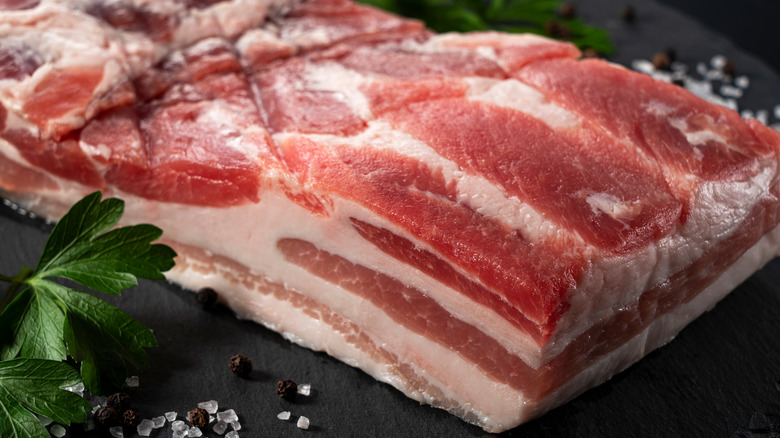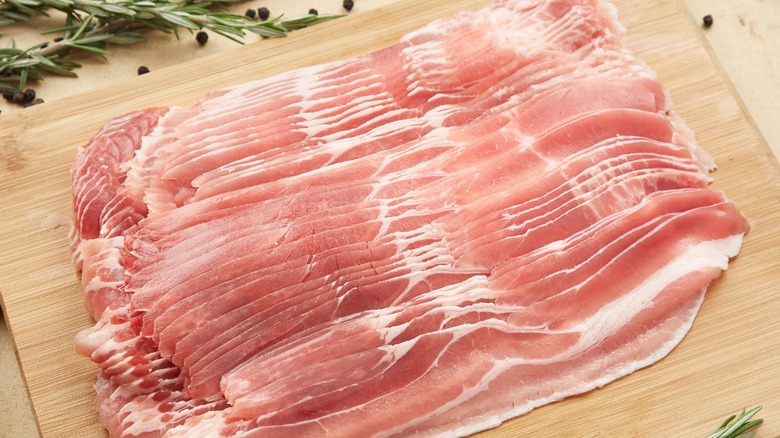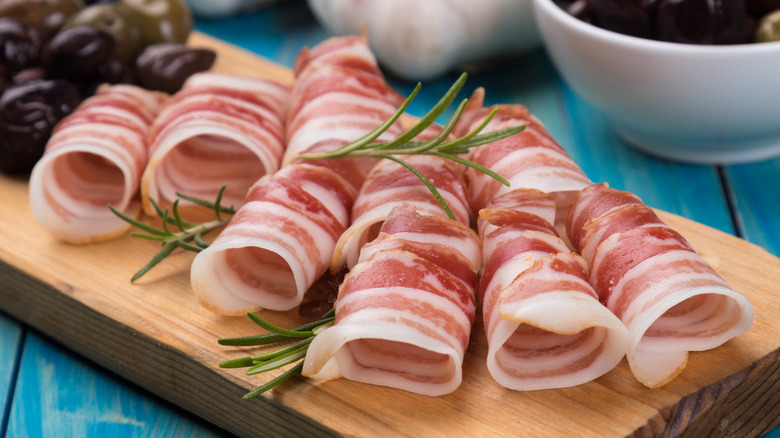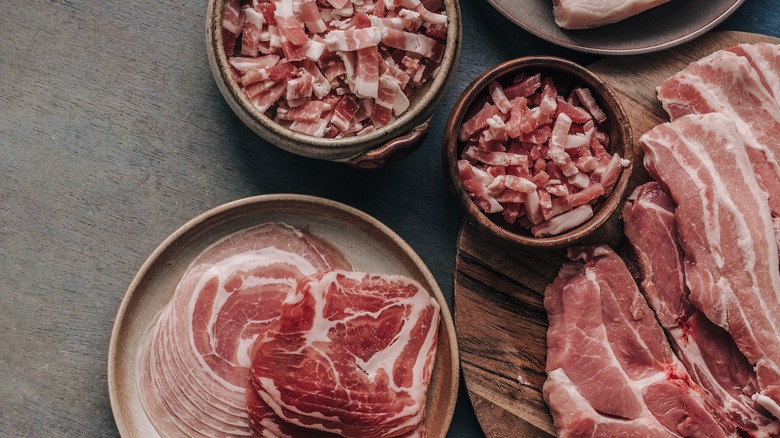What Makes Pancetta And Bacon Different?
Ever heard the phrase, "Bacon makes it better?" For many Americans, this certainly seems to be the consensus. Per WorldAtlas, in 2018, the average U.S. consumer ate 23.6 kg (roughly 52 pounds) of pork every year, most commonly in the form of bacon. In fact, August 20 is National Bacon Lovers Day (via National Today).
Folks have been loving bacon for centuries. Pigs were first domesticated around 8500 B.C., and bacon-eating has been recorded as early as 1500 B.C. But what about bacon's close relative — pancetta? Perhaps you've considered pancetta the Italian equivalent of the smoky, crispy meat. But don't get it twisted, says Herb Eckhouse, co-founder and co-owner of cured pork processor La Quercia. "In fact," Eckhouse explains, via Meat + Poultry, "pancetta is sometimes called 'Italian bacon.' But it is not what we usually think of in the United States as bacon." There's a reason why you might find pancetta on a charcuterie board and not bacon. Why? The difference between these two types of cured pork might seem intuitive to many home cooks, but what makes pancetta and bacon different? Let's break it down.
Bringing home the bacon
According to the USDA, bacon is "the cured belly of a swine (hog) carcass. If meat from other portions of the carcass is used, the product name must identify the portions where the bacon comes from, e.g., 'Pork Shoulder Bacon.'" Although, there's some debate between sources about which area of the pig bacon typically comes from. Per The Spruce Eats, most bacon comes from the pig's side. Herb Eckhouse agrees with the USDA, adding that 90% of U.S. bacon comes from pork belly (via Meat + Poultry).
Bacon has a centuries-old history. The 11th-century Saxons of Britain cooked "bacoun," per The English Breakfast Society. Others used Proto-Germanic "bakkon" or "bacun" in Old French. Maybe you've heard the phrase "bring home the bacon" referring to earning money. In 12th-century England, at one church in Dunmow, men would get to bring home a portion of bacon if they could swear before the church that they and their spouse hadn't fought in a year and one day.
Either way, bacon is a very fatty cut of meat. That's why bacon shrinks when you cook it, says Bacon Scouts. Before it can be cooked, bacon undergoes a curing process during which it is soaked in nitrates, sugar, and salt. The Spruce Eats notes the main distinction that separates bacon from pancetta is that it is smoked and typically served as bacon bits or sliced into strips 1/16 inches thick.
The perks of pancetta
Introducing pancetta: bacon's hot, cooler older sister. That isn't, admittedly, the technical definition. Per Merriam-Webster, pancetta is "unsmoked bacon used especially in Italian cuisine." According to Britannica, the Italian word "pancetta" comes from the same linguistic derivation as the English "paunch," meaning belly. The Italian region of Piacenza is the only place in the world where "pancetta piacentini" — a deep red variation — is produced. It's an Italian creation through and through.
Like bacon, pancetta comes from the pork belly and is also cured, but instead of salt and nitrates, pancetta is cured in a blend of spices, commonly including black pepper, ground cinnamon, nutmeg, and cloves, per Food Network. Then, unlike bacon, pancetta rests for 8 to 15 days after seasoning to dry (via Leite's Culinaria). Since the cuts of meat and their processing are so similar, says MyRecipes, pancetta has a similar savory flavor to bacon but without bacon's signature smokiness. Also, unlike bacon, pancetta is typically eaten uncooked and served as thinly rolled sheets or diced into cubes.
How to know which one to pick
Knowing whether to opt for bacon or pancetta is all about choosing the right tool for the job. Keep taste and texture in mind as you would with any other ingredient in your culinary arsenal. If you want a crispy, smoky bite for your dish, bacon is the way to go. It's an ideal crunchy salad topping. Its smoky taste lends well to baked or green beans (via Food Network). Its fatty, crisp mouthfeel makes bacon an excellent fit for avante-garde sweets like candied or chocolate-covered bacon. Or add a couple of strips to make a BLT sammie.
Per Food Network, pancetta has a deeper pork flavor than bacon since its smoked taste doesn't mask porkiness. Pancetta also has a silkier texture in contrast to bacon's crispiness, says MyRecipes. So, when you want a savory, meaty, yet soft bite, pancetta is the move for your dish. Pancetta can be eaten cold as deli meat on a sandwich. It can take your mac and cheese to the next level. It's the star of many bolognese and the signature ingredient in pasta carbonara (via An Italian in My Kitchen).



